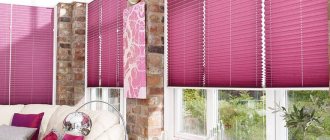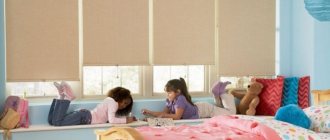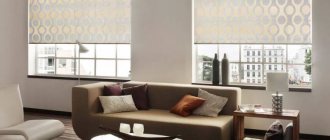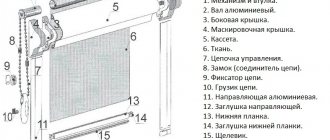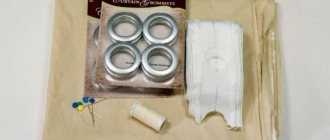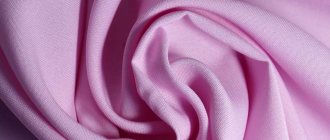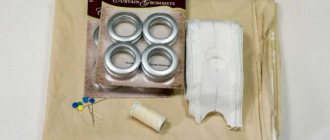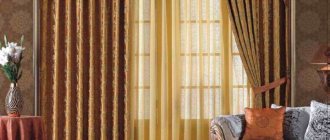Pleated curtains are increasingly used in modern interiors. They are suitable for any windows, easy to install, and do not cause problems in operation and maintenance. Any design can be applied to them, which makes them a valuable element of the stylish design of the room.
The design of pleated curtains is universal, as it suits any window shape.
Pleated curtains: what are they and what do they look like?
Pleated curtains are one of the newest and most modern models of light protection. Visually they are similar to classic blinds. But this is only at first glance. The design, materials and other characteristics differ from Roman roller shutters or classic blinds.
Externally, the design of such curtains resembles ordinary horizontal blinds, but with pleated fabric, that is, with clear folds.
Corrugated curtains are a lightweight, elegant design, easy to use, which consists of several simple parts:
Accordion-shaped canvas
Single ones are a single fabric with folds. Double or triple ones consist of several fabrics, sewn like a honeycomb.
Pleated is a small fold that does not lose its shape, does not sag, and allows the panel to be folded and unfolded. The direction of the folds is usually horizontal, but vertical folding is also common. The material used is fabric or paper impregnated with a special composition. Treatment with a solution is necessary in order to protect the fabric or paper from fading and getting wet.
Their width can range from 10-50 mm.
Aluminum profile
Pleated curtains are blinds made of pleated material, fixed on both sides in a special profile cornice.
Used for reliable fastening of the mechanism. The cornice and side profiles allow you to install the corrugation so that it hangs freely or secure it to the sides. If the structure is attached to inclined surfaces, then a cable is added to it for strength.
They are held on the glass using guides, which are strings stretched between the upper and lower strips of the cornice.
Control system
With its help, curtains unfold and collapse. Control types may vary depending on the model:
The control mechanism for such curtains on non-standard windows is carried out using a chain, cord, handle, leash for windows located high enough, or a remote control.
- Manual adjustment. Special chains or laces are used to gather or loosen the folds.
- Electric drive. The canvas rises and falls under the control of a mechanism that is activated remotely by a remote control.
- No adjustment. They are installed permanently and do not provide for control.
Models of pleated blinds for inclined and roof windows
Pleated curtains of this series are designed for installation on sloping and roof windows with an inclination angle of up to 60°. These are tension-type models of only rectangular shape with mandatory fixation of the structure at the top and bottom. Pleated curtains for roof windows differ from conventional tension models by the presence of an additional side tension cord with a diameter of 1.2 mm, which prevents the curtain from sagging. In cases where the roof window is located at a high height, a control handle extension can be ordered as an additional option.
Pleated curtains for plastic windows: varieties, methods of fastening, materials
There are several options for pleated models. They differ in the type of movement, method of fastening, direction of folds, and type of material.
Rolled. The corrugated fabric is rolled onto a roller fixed at the top.
The principle of operation is very simple.
Loose hanging. The device does not involve fixing the canvas from below. The panel is fixed only at the top.
Suitable for ordinary windows, standard shapes and dimensions.
Tension. Corrugated fabric or paper is completely fixed in them. A string is pulled through the side bars, which ensures reliable tension of the fabric or paper.
The canvas is framed and therefore there is no risk of sagging or stretching.
Up-down system. The up-down system allows you to partially open both the lower and upper parts of the window.
You just need to raise the roller shutter up or lower it down.
Vertical. The curtains are fixed on the side, the direction of movement is not upward, but to the sides.
The folds are located not across, but along.
Stationary. They are tightly fixed and are not designed to open or close. This option is often used on windows of complex or non-standard shapes.
For example, arched configurations with many small details.
There are also different methods for attaching pleated curtains to plastic windows. Light weight allows for different fixation options.
- Frame mounting. This method is the most common. Performed using self-tapping screws and brackets.
- Fixation in the opening. The corrugated panel is not attached to the plastic, but inside the opening. Suitable only in cases where there is at least 7 cm of distance between the frame and the opening. An ideal option for blind, non-opening doors.
- On the wall above the opening. The lightweight system can be mounted not only in the window space, but also above it.
When open, a pleated curtain on a window can completely cover a window or even a doorway.
The materials used to produce corrugated or pleated curtains can have varying degrees of shading.
- Transparent. The canvas is fully illuminated, transmits light well, but still protects the owners of the room from prying eyes.
- Translucent. Only partially lets light into the room.
- Blackout. Completely opaque shading option. If you close the roller shutter, the room will be completely plunged into darkness.
Pleated pleats can be purchased in stores ready-made, created to fit standard plastic frames, or contact specialized companies and have them made to order.
One of the important advantages of corrugated curtains is the ability to choose a design to suit any style of room. Paper and woven fabric allows you to print different prints that will suit any taste and help create coziness in the room.
Pleated curtains with a pattern in the interior look more comfortable and “homey”.
Pleated curtains for roof windows
Pleated curtains are an excellent choice for skylights. After all, the unusual configuration of the frames and their inclined position makes it impossible to use classic curtains. Corrugated curtains weigh little, they can be fixed at an angle, and the choice of models is so diverse that any design experiments can be successfully brought to life.
Pleated blinds differ in material, shape, size, and type of construction.
Externally, corrugations for the attic are no different from standard modifications. The difference lies in the way the solar shading system is controlled and mounted. Due to the inclined position of the opening, the curtains are fixed with side slats. Tight fastening does not allow the fabric to sag. And to make control at an angle possible, use a special leash handle or bar.
The material for such curtains is something between oilcloth and fabric.
Caring for pleated curtains
Caring for pleated curtains directly depends on the material from which they are made. Any pleated curtains accumulate dust in the folds. Pleated paper curtains and curtains made from natural fabrics should be fanned with a dust broom and wiped with a dry cloth. Moisture-resistant curtains can be wiped with a damp cloth.
Some curtains indicate that they are washable. Wash the curtains in a basin with warm water and hand washing powder. The panel with the lifting mechanism must remain dry.
Often during operation the cord may fray. It can be easily replaced in any design.
Choose pleated curtains based on the type of design and color of the material. If you want something original, choose day-night curtains or those that can be assembled on both sides - both bottom and top.
How to attach pleated curtains with your own hands?
Depending on where the light protection system will be mounted, one or another installation method is selected. There may be several of them.
Installation in the opening, in the glazing bead
Installation is carried out using ceiling and (or) window sill brackets. The choice depends on the model.
Some varieties have dirt- and dust-repellent impregnation.
The installation scheme consists of several stages:
- Marking. It is necessary to mark the installation location. To do this, measure a distance from the glass of 3 mm if the canvas is ordinary and 5 mm if the black out system is used. In order to set the required distance, a setting stop is used.
- The brackets are fastened with screws.
- If the design involves window sill brackets, then it is necessary to make markings for the installation stop. First, the width of the canvas is measured. The support is then inserted into the mounting stop and the installation location is marked. The outer edges of the stops must match the width of the product. Next, a hole is drilled and the support is screwed on.
- Installation of cornice. The upper cornice is inserted into the ceiling brackets.
- Then you need to attach the lower brackets to the screwed supports.
Often the material is treated with special compounds that provide fire resistance.
Important! When installing, make sure that the adjustment cords are located on the outside of the curtains.
Installation on an opening (on a frame, on a wall)
Installation is carried out according to a similar scheme, only wall brackets are used for installation on the opening. They are screwed to the frame or wall with screws. The cornice is installed in the same way as in the previous case.
Pleated paper sheets are the most budget option.
Sash mounting
Drilling is not required in this case. Fixation is carried out using cap brackets for each sash separately. Sometimes the package includes window sill brackets. Then the support is screwed to the bracket with screws.
Today you can buy pleated curtains for windows of any shape or make them yourself.
Important. There is an opinion that drilling spoils the hermetic properties of the frame, and they begin to let air and moisture through the holes. This assumption is erroneous, since all double-glazed windows include several air chambers. But if you don’t want to drill holes in the frame, you can use throw-on brackets or double-sided tape for fixation.
Installation of pleated curtains is simple, which means inexpensive and quick
With a design of any complexity, installation of curtains is distinguished by its simplicity and requires a minimum of time. Installation is carried out:
- on a section of the wall (roof or ceiling) adjacent to the window (door) opening;
- inside a window (door) opening;
- into the neck of the hatch;
- on the door frame;
- on a transparent partition or wall of the winter garden;
- on the window frame;
- directly on the door or hatch cover.
In any case, the supporting structure (cornice) of the curtain is mounted on special brackets using screws (self-tapping screws). If the weight of the structure is small, then it will be securely held using adhesive tape (special tape) or glue.
When installing on a window in a standard vertical wall, mounting directly to the frame is usually used. This allows, firstly, to use the window sill to the maximum; secondly, in addition to pleated curtains, hang in the room exactly those decorative curtains that correspond to the overall design concept. Naturally, the second case is not always used, since the design of pleated curtains easily and harmoniously fits into most modern interior styles.
An option for a successful combined solution. Installation of pleated fabrics directly on the frame, together with stylish curtains
Attic solution. The pleated curtain feels confident (without sagging!) on a window in a sloping roof
Solution with installation on the eaves
Installation directly on the frame. Combination of designs of different formats
How to make pleated paper curtains with your own hands
Buying ready-made pleats and installing them is the easiest way out. But there is another option for shading the room from the sun. The construction of corrugated curtains is so simple that you can easily make paper curtains yourself.
Hand made blinds will add their own zest to the interior and give the room a special flavor.
Materials you will need
- Paper. The most suitable option is a piece of wallpaper with a non-woven base, intended for painting. The paper allows enough light to pass through while providing good shade from the sun. The thickness of the paper will allow you to maintain the “accordion” shape for a long time.
- Wood slats – 2 pcs. The cross-section should be square, 10 x 10 mm.
- Ruler and pencil.
- Rope, cord, tape - optional. The main thing is that the color matches the overall interior.
- Hole puncher or awl.
- Glue.
- Scotch. You will need two types: one-sided and two-sided.
- Large bead. It will act as a fixative.
Instructions
The laconic design attracts many people.
Step 1. You need to measure the width and height of the window.
Step 2. Mark the workpiece on paper using measurements. In this case, you need to add 30-40 cm to the measured height for the future “accordion”.
Step 3. Cut out the workpiece. Then turn it over to the wrong side and iron it with an iron.
Step 4. Using a ruler and pencil, mark the folds on both sides of the paper. The width and depth of the folds will depend on the design idea.
Step 5. Using the markings, you need to fold the accordion. To make the folds more expressive, you can run a ruler along the fold. The last fold looks inward.
Step 6. When folded, the accordion is pierced in the center with a hole punch. Then a rope is pulled through the hole. The ends are tied, secured with a bead at the bottom and single-sided tape at the top. If the canvas is wide, then the rope is passed not in the center, but along the sides, retreating 4-5 cm from the outer edges of the paper.
Step 7. The upper and lower parts are glued with double-sided tape. The strips are glued to both sides with tape. The top one will be the cornice, and the bottom one will be the weighting material. You can attach the structure to the frame without a strip - using double-sided tape.
Advice. If the width of the frames is large and one width of wallpaper is not enough, a canvas can be made by gluing two strips of wallpaper with tape or glue.
The best examples of using pleated curtains in the interior, photos
Corrugated curtains are used to shade any room. Most often they are installed in attics or terraces. But now such models are actively used by designers in creating modern interiors. With their help, styles such as minimalism, hi-tech, contemporary, loft, grunge are complemented. If we talk about classics, then blinds alone are not enough.
It is better to add standard curtains or tulle to the set.
Corrugated curtains are suitable for any room design. And their tension-holding ability and light weight make them one of the most sought-after shading options for dormers and custom windows.
Pleated curtains Day-Night
In pleated day-night models, two fabrics are used, as a rule, one of them is blackout fabric for complete darkening or a fairly dense semi-darkening fabric, the second is light translucent, replacing traditional tulle on the window for daytime use. With the help of two fabrics that differ radically in density, you can easily vary the illumination of a room in cases where it is impossible to leave the window open. Day-night pleated curtains are installed only on rectangular windows; they can be controlled either with a leash handle or with a cord, chain or electric drive.
